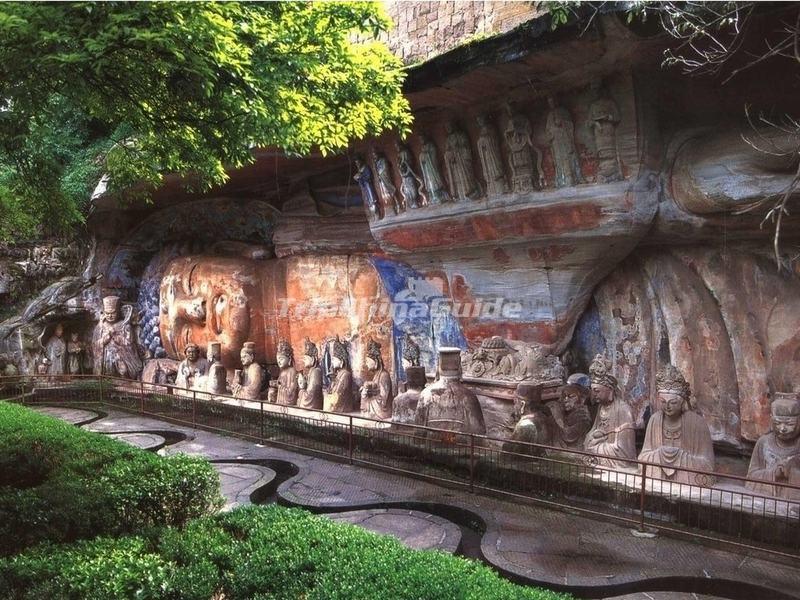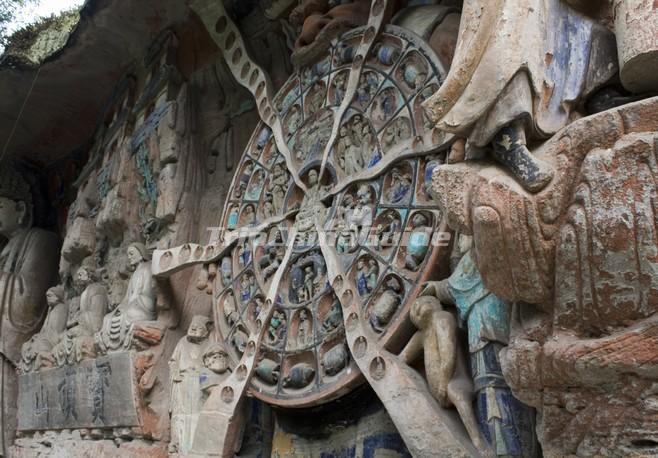Dazu Rock Carvings Facts
The Dazu Rock Carvings are a series of Chinese religious sculptures and carvings, dating back as far as the 7th century AD, depicting and influenced by Buddhist, Confucian and Taoist beliefs. Listed as a World Heritage Site in 1999, the Dazu Rock Carvings are made up of 75 protected sites containing some 50,000 statues, with over 100,000 Chinese characters forming inscriptions and epigraphs. The sites are located in Chongqing Municipality within the steep hillsides throughout Dazu County, located about 60 kilometers west of the urban area of Chongqing. The highlights of the rock grotto are found on Mount Baoding and Mount Beishan.
History of Dazu Rock Carvings
The earliest carvings were begun in 650 AD during the early Tang Dynasty, but the main period of their creation began in the late 9th century, when Wei Junjing, Prefect of Changzhou, pioneered the carvings on Mount Beishan, and his example was followed after the collapse of the Tang Dynasty by local and gentry, monks and nuns, and ordinary people during the Five Dynasties and Ten Kingdoms period (907-65). In the 12th century, during the Song Dynasty, a Buddhist monk named Zhao Zhifeng began work on the elaborate sculptures and carvings on Mount Baoding, dedicating 70 years of his life to the project.
Off limits to visitors for many years, the carvings were opened to Chinese travelers in 1961 and foreign visitors in 1980. Until 1975 there was only a muddy path between the town of Dazu and the main cluster of carvings. The isolation helped keep the art unharmed during the massive anti-religious vandalism of the Cultural Revolution.
Major Carvings
1. Mount Baoding Carvings
Mount Baoding Carvings is located 5 kilometers from the northeast of Dazu County, where Buddha statues carved on 2500-meter-high cliffs are ubiquitous. The statues in Dafowa and Xiaofowan revolving with Shenshou Temple could be found.
2. Mount Nanshan Carvings
Mount Nanshan Carvings is situated 2.5 kilometers southwest of Dazu County. Atop the Mount Nanshan, the Taoist Temple named Jade Emperor Temple was originally built. The Mount Nanshan Carvings were begun in 1127 AD-1279 AD during the South Song Dynasty, belonging to Daoist statuary.
3. Mount Beishan Carvings
Mount Beishan Carvings is 2 kilometers from the northwest of Dazu County. Mount Beishan Carvings was started to build in late Tang Dynasty and accomplished in South Song Dynasty, which is one of the two largest carvings in Duzong Rock Carvings. The nearly 10,000 statues were built in Fowan, Yingpanpo, Guanyinpo, Northern Tower Temple, Fo'er cliff, etc. Carvings on Beishan are featured with exquisite engravings, sophisticated skill and fine workmanship, which appeals numerous travelers home and abroad to pay a visit.
4. Mount Shizhuan Carvings
Mount Shizhuan Carvings is located 25 kilometers southwest of Duzu County, they were begun in 1082 AD-1096 AD during the North Song Dynasty, with an altitude of 444.6 meters, and the carvings on Mount Shizhuan are mostly carved onto cliffs. Here, Buddhist, Taoist and Confucius statues are well-merged with each other, which is quite rare in Chinese grotto art.
5. Mount Shimen Carvings
Mount Shimen is located 20 kilometers from the eastern part of Dazu County. Mount Shimen Carvings were started to build in 1094 AD-1151 AD during North Song Dynasty to South Song Dynasty. Here, Buddhism and Taoism are well merged, while the Taoist statue is more predominant.















